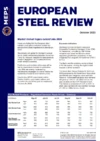Improving prospects for UK steel beam market
Political and economic developments in the United Kingdom may prove to be the catalyst for improvements in the steel beam market during the second half of 2024.
MEPS International’s research partners in the country report that the UK beam market has been subdued since the end of 2023. Election promises and interest rate cuts are bringing hope of improved trading conditions, however.
MEPS steel market analyst, Chris Jackson, said the UK beam market had been in a “state of flux” for quite some time, but added: “There is good news on the horizon. Whatever the result, July's election should provide a degree of certainty while the high likelihood of interest cuts by the Bank of England will ease financial pressures and could prompt an increase in construction activity. This would provide a timely boost to steel market participants."
Steel manufacturers in mainland Europe have made a series of attempts to raise their prices for long products in the past six months. During April’s Wire and Tube Fair, in Düsseldorf, ArcelorMittal raised its list prices by EUR20-30 per tonne.
As reported in MEPS’s May European Steel Review, the steelmaker’s price initiative, which was soon followed by other beam mills, largely failed. Weak demand continues to undermine regional suppliers’ efforts to realise gains.
In the United Kingdom, beam prices remained flat in May. Buyers remained unwilling to pay more for their material, but the attempted rises did, at the very least, help manufacturers to stave off the threat of further price erosion.
The UK beam market is at an impasse. Amid weak demand in most beam-consuming sectors, there is little incentive for producers to lower their prices further as this is unlikely to prompt an increase in orders.
Participants at the recent North Eastern Association of Steel Stockholders (NEASS) meeting in Leeds, which was attended by MEPS, labelled the first quarter of 2024 as “tough and challenging”. There were few signs of improvement in quarter two.
Many UK companies involved in long products find themselves in a precarious financial position. Several MEPS respondents readily admit that they face a “fight for survival” given their lack of orders.
There are a number of reasons for this.
Subdued economy, weak demand
UK service centres are still in destocking mode and keep their new purchasing requirements at a minimum. MEPS research partners report that the outsell prices being offered by UK stockists are almost level with mill replacement costs.
Tight economic conditions – partially created by measures implemented to combat inflation – are having a detrimental impact on end-user activity. Many procurement and investment decisions were put on hold as a result.
Similar trends are noted in all European countries. Consequently, UK beam stockists are finding that their export opportunities have become limited. Moreover, they are facing increased competition in their home market as EU firms look to sell their surplus material into the UK.
Changes which could bring the UK beam market out of its “state of flux”, and improve steel demand, might be on the way, however.
Catalysts for change
Recent uncertainty surrounding the timing of the UK general election has now been alleviated. Campaigning by the major political parties is now ramping up ahead of voting on July 4. Election promises are likely to result in increased public infrastructure spending.
The high cost of finance that has been cited as an impediment to trade may also be about to ease. On May 9 the Bank of England decided to maintain interest rates at 5.25% for the fifth time in a row. Nonetheless, with inflation nearing the UK government’s 2% target, economic analysts predict that interest rate cuts will soon be implemented.
Lower interest rates will provide a welcome boost to the flagging UK construction industry. Faced with stable or falling interest rates, UK builders will be able to plan ahead with a degree of certainty.
MEPS believes that beam prices have reached the bottom of the (current) cycle in the UK. A gradual improvement in activity – resulting from both the economic and political reasons outlined above – should help beam mills, along with the EU producers who sell into the country, push through price increases in the coming months.
However, any recovery in construction activity is likely to be modest as the influence of these changes take time to come to fruition. This could threaten the sustainability of any price gains in the near term.

Source:
European Steel Review
The MEPS European Steel Review is an informative, concise and easy-to-use monthly publication, offering unique professional insight into European carbon steel prices.
Go to productRequest a free publication





